The Changing Tendency and Association Analysis of Intelligent Coal Mines in China: A Policy Text Mining Study
Abstract
:1. Introduction
2. Text Feature Analysis of Coal Mine Intelligent Policy Based on Text Preprocessing
2.1. Text Source and Preprocessing
2.2. Word Cloud Display
3. Co-Occurrence Network Analysis and Centrality Analysis of Key Contents of the Intelligent Policy Text
3.1. Co-Occurrence Network Construction
3.2. Centrality Analysis
4. Text Analysis of Intelligent Policies in Recent Years
4.1. Relationship Network Analysis of High-Frequency Words in Intelligent Policies from 2016 to 2022
4.2. Application of Intelligent Key Technologies in Mines
5. Conclusions
Author Contributions
Funding
Institutional Review Board Statement
Informed Consent Statement
Data Availability Statement
Conflicts of Interest
References
- Wang, G.F.; Xu, Y.X.; Ren, H.W. Intelligent and ecological coal mining as well as clean utilization technology in China: Review and prospects. Int. J. Min. Sci. Technol. 2019, 29, 161–169. [Google Scholar] [CrossRef]
- Wang, G.F.; Ren, H.W.; Zhao, G.R.; Zhang, D.S.; Wen, Z.G.; Meng, L.Y.; Gong, S.X. Research and practice of intelligent coal mine technology systems in China. Int. J. Coal Sci. Technol. 2022, 9, 17. [Google Scholar] [CrossRef]
- Valuev, A.M.; Volkova, L.P. Problems of Intelligent Automation of Unmanned Underground Coal Mining. In Proceedings of the 2nd International Conference of Artificial Intelligence, Medical Engineering, Education (AIMEE), Moscow, Russia, 6–8 October 2018; Springer International Publishing: Moscow, Russia, 2018; pp. 507–516. [Google Scholar]
- Liu, T.Y.; Wang, Z.W.; Li, Z.; Jin, G.X.; Wang, J.Q.; Hu, J.; Li, Y.F.; Wei, Y.B.; Ning, Y.N.; Yang, Q.S. Advance of Laser and Fiber Optic Sensors for Applications of Coal Mine Safety Monitoring and Early Warning. Laser Optoelectron. Prog. 2021, 58, 11. [Google Scholar]
- Chen, W.; Wang, X.Z. Coal Mine Safety Intelligent Monitoring Based on Wireless Sensor Network. IEEE Sens. J. 2021, 21, 25465–25471. [Google Scholar] [CrossRef]
- Mitra, S.; Kumar, D.; Chaulya, S.K.; Kumar, C. Prediction of Strata Monitoring System in Underground Coal Mines Using IoT. J. Geol. Soc. India 2022, 98, 232–236. [Google Scholar] [CrossRef]
- Wu, Y.Q.; Chen, M.M.; Wang, K.; Fu, G. A dynamic information platform for underground coal mine safety based on internet of things. Saf. Sci. 2019, 113, 9–18. [Google Scholar] [CrossRef]
- Sun, Y.T.; Bi, R.Y.; Sun, J.B.; Zhang, J.F.; Taherdangkoo, R.; Huang, J.D.; Li, G.C. Stability of roadway along hard roof goaf by stress relief technique in deep mines: A theoretical, numerical and field study. Geomech. Geophys. Geo-Energy Geo-Resour. 2022, 8, 16. [Google Scholar] [CrossRef]
- Sun, Y.T.; Bi, R.Y.; Chang, Q.L.; Taherdangkoo, R.; Zhang, J.F.; Sun, J.B.; Huang, J.D.; Li, G.C. Stability Analysis of Roadway Groups under Multi-Mining Disturbances. Appl. Sci. 2021, 11, 7953. [Google Scholar] [CrossRef]
- Li, G.C.; Sun, Y.T.; Qi, C.C. Machine learning-based constitutive models for cement-grouted coal specimens under shearing. Int. J. Min. Sci. Technol. 2021, 31, 813–823. [Google Scholar] [CrossRef]
- Sun, Y.T.; Li, G.C.; Yang, S. Rockburst Interpretation by a Data-Driven Approach: A Comparative Study. Mathematics 2021, 9, 2965. [Google Scholar] [CrossRef]
- Sun, Y.T.; Li, G.C.; Zhang, J.F.; Huang, J.D. Rockburst intensity evaluation by a novel systematic and evolved approach: Machine learning booster and application. Bull. Eng. Geol. Environ. 2021, 80, 8385–8395. [Google Scholar] [CrossRef]
- Sun, Y.T.; Li, G.C.; Zhang, N.; Chang, Q.L.; Xu, J.H.; Zhang, J.F. Development of ensemble learning models to evaluate the strength of coal-grout materials. Int. J. Min. Sci. Technol. 2021, 31, 153–162. [Google Scholar] [CrossRef]
- Zhang, F. A hybrid structured deep neural network with Word2Vec for construction accident causes classification. Int. J. Constr. Manag. 2022, 22, 1120–1140. [Google Scholar] [CrossRef]
- Wang, Z.H.; Zhang, B.K.; Gao, D. Text Mining of Hazard and Operability Analysis Reports Based on Active Learning. Processes 2021, 9, 1178. [Google Scholar] [CrossRef]
- Xu, N.; Ma, L.; Liu, Q.; Wang, L.; Deng, Y.L. An improved text mining approach to extract safety risk factors from construction accident reports. Saf. Sci. 2021, 138, 12. [Google Scholar] [CrossRef]
- Zhong, B.T.; Pan, X.; Love, P.E.D.; Ding, L.Y.; Fang, W.L. Deep learning and network analysis: Classifying and visualizing accident narratives in construction. Autom. Constr. 2020, 113, 11. [Google Scholar] [CrossRef]
- Sharma, A.K.; Chaurasia, S.; Srivastava, D.K. Sentimental Short Sentences Classification by Using CNN Deep Learning Model with Fine Tuned Word2Vec. In Proceedings of the International Conference on Computational Intelligence and Data Science (ICCIDS), Gurugram, India, 6–7 September 2019; Elsevier: Gurugram, India, 2019; pp. 1139–1147. [Google Scholar]
- Fa, Z.W.; Li, X.C.; Liu, Q.L.; Qiu, Z.X.; Zhai, Z.Y. Correlation in Causality: A Progressive Study of Hierarchical Relations within Human and Organizational Factors in Coal Mine Accidents. Int. J. Environ. Res. Public Health 2021, 18, 5020. [Google Scholar] [CrossRef]
- Fei, X. An LDA based model for semantic annotation of Web English educational resources. J. Intell. Fuzzy Syst. 2021, 40, 3445–3454. [Google Scholar] [CrossRef]
- Qiu, Z.X.; Liu, Q.L.; Li, X.C.; Zhang, J.J.; Zhang, Y.Q. Construction and analysis of a coal mine accident causation network based on text mining. Process Saf. Environ. Protect. 2021, 153, 320–328. [Google Scholar] [CrossRef]
- Ahadh, A.; Binish, G.V.; Srinivasan, R. Text mining of accident reports using semi-supervised keyword extraction and topic modeling. Process Saf. Environ. Protect. 2021, 155, 455–465. [Google Scholar] [CrossRef]
- Garg, M.; Kumar, M. The structure of word co-occurrence network for microblogs. Phys. A 2018, 512, 698–720. [Google Scholar] [CrossRef]
- Li, P.; He, Y.; Li, Z. Study on Influencing Factors of Construction Workers’ Unsafe Behavior Based on Text Mining. Front. Psychol. 2022, 13, 886390. [Google Scholar] [CrossRef] [PubMed]
- Luo, X.X.; Liu, Q.L.; Qiu, Z.X. A Correlation Analysis of Construction Site Fall Accidents Based on Text Mining. Front. Built Environ. 2021, 7, 13. [Google Scholar] [CrossRef]
- Wang, Z.; Li, H.J.; Tang, R.W. Network analysis of coal mine hazards based on text mining and link prediction. Int. J. Mod. Phys. C 2019, 30, 22. [Google Scholar] [CrossRef]
- Zhong, B.T.; Pan, X.; Love, P.E.D.; Sun, J.; Tao, C.J. Hazard analysis: A deep learning and text mining framework for accident prevention. Adv. Eng. Inform. 2020, 46, 12. [Google Scholar] [CrossRef]
- Li, H.J.; An, H.Z.; Wang, Y.; Huang, J.C.; Gao, X.Y. Evolutionary features of academic articles co-keyword network and keywords co-occurrence network: Based on two-mode affiliation network. Phys. A 2016, 450, 657–669. [Google Scholar] [CrossRef]
- Kim, T.; Chi, S. Accident Case Retrieval and Analyses: Using Natural Language Processing in the Construction Industry. J. Constr. Eng. Manag. 2019, 145, 13. [Google Scholar] [CrossRef]
- Liu, G.Y.; Boyd, M.; Yu, M.X.; Halim, S.Z.; Quddus, N. Identifying causality and contributory factors of pipeline incidents by employing natural language processing and text mining techniques. Process Saf. Environ. Protect. 2021, 152, 37–46. [Google Scholar] [CrossRef]
- Li, S.; You, M.J.; Li, D.W.; Liu, J. Identifying coal mine safety production risk factors by employing text mining and Bayesian network techniques. Process Saf. Environ. Protect. 2022, 162, 1067–1081. [Google Scholar] [CrossRef]
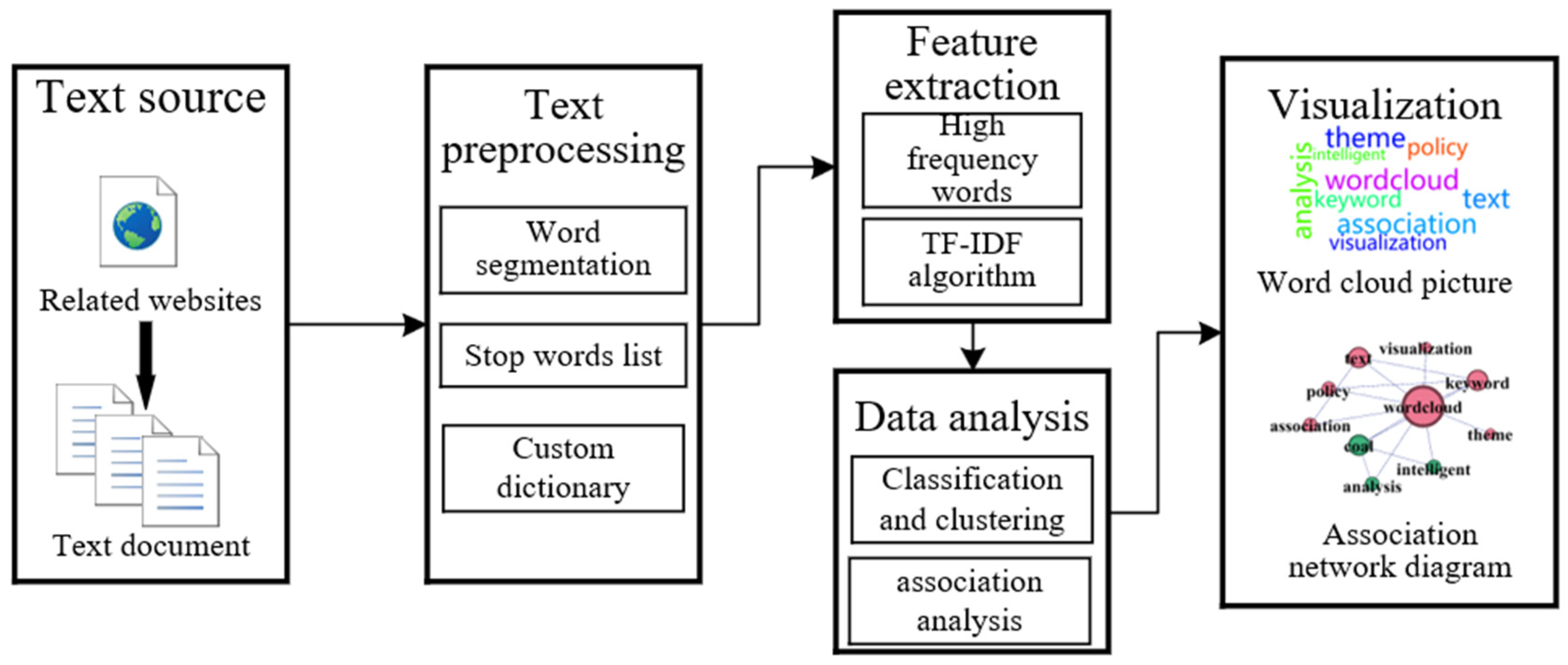
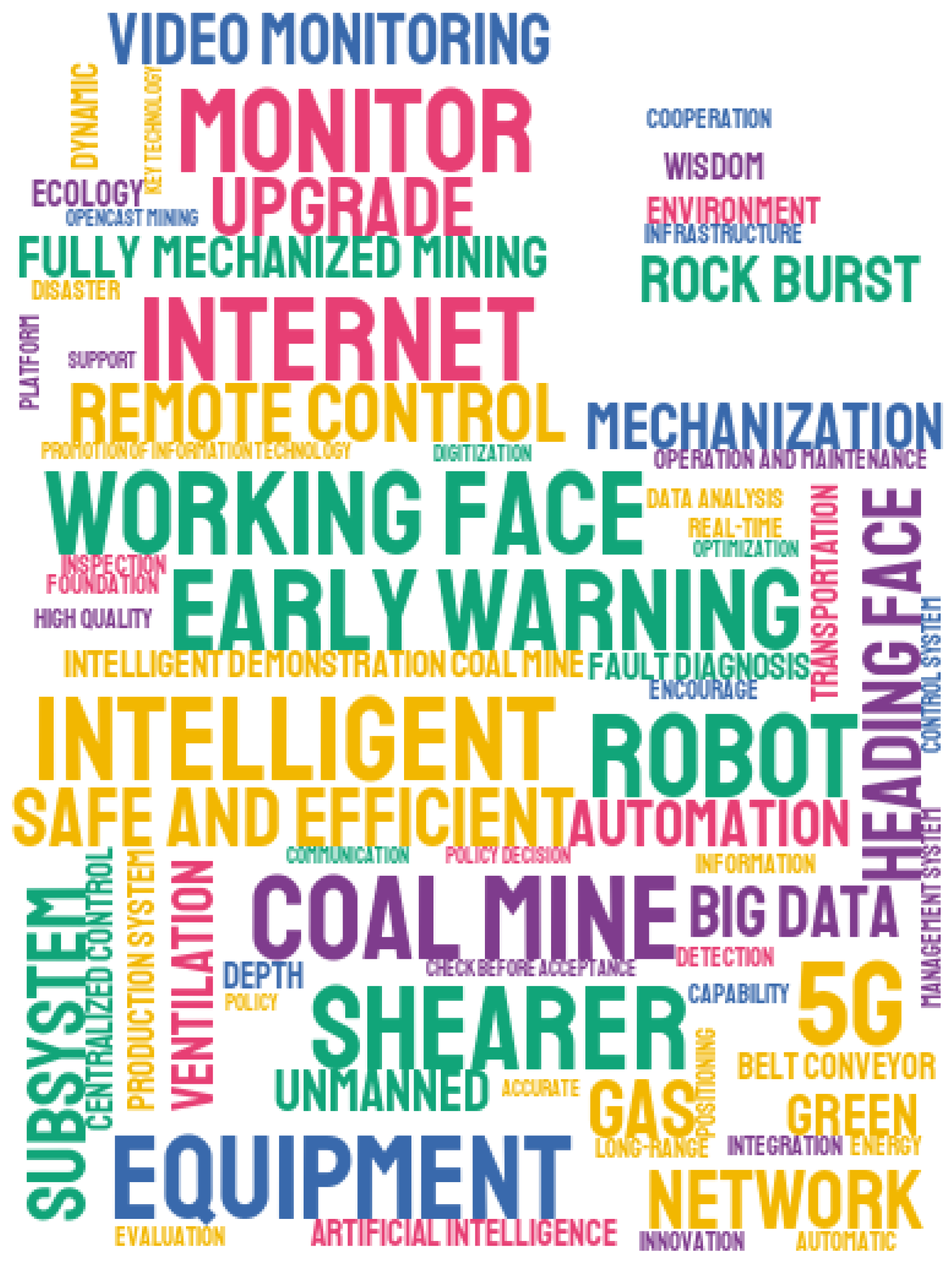
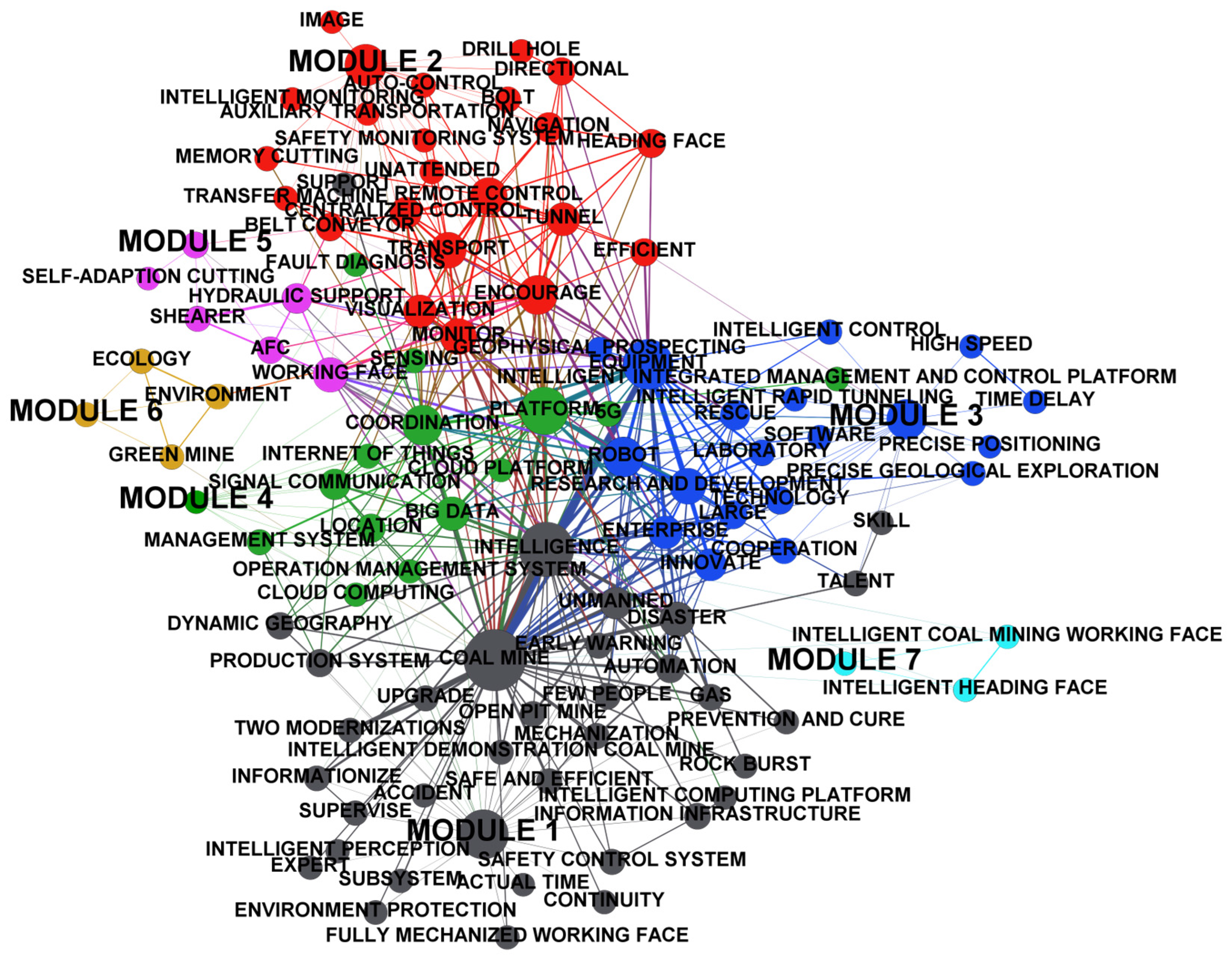
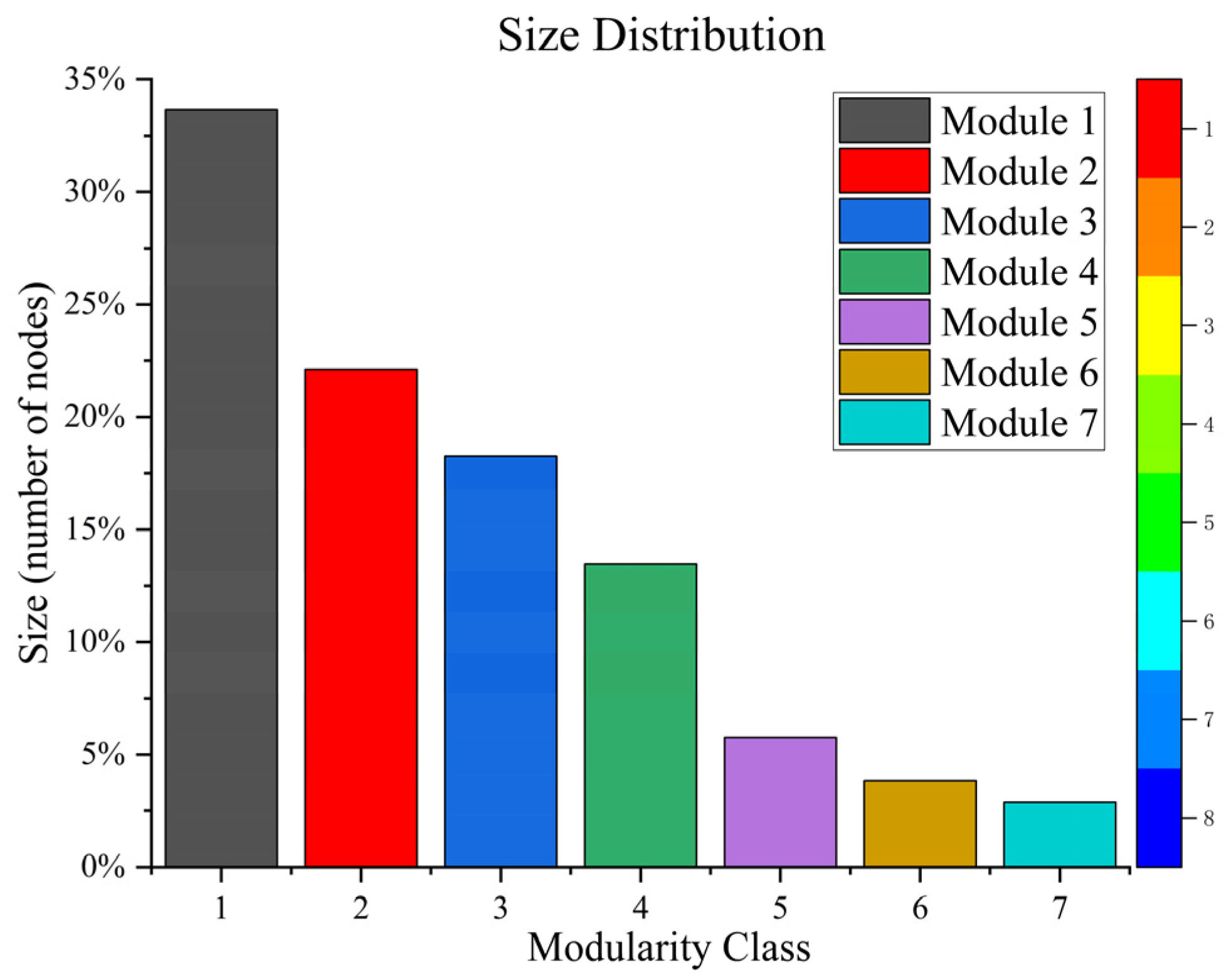
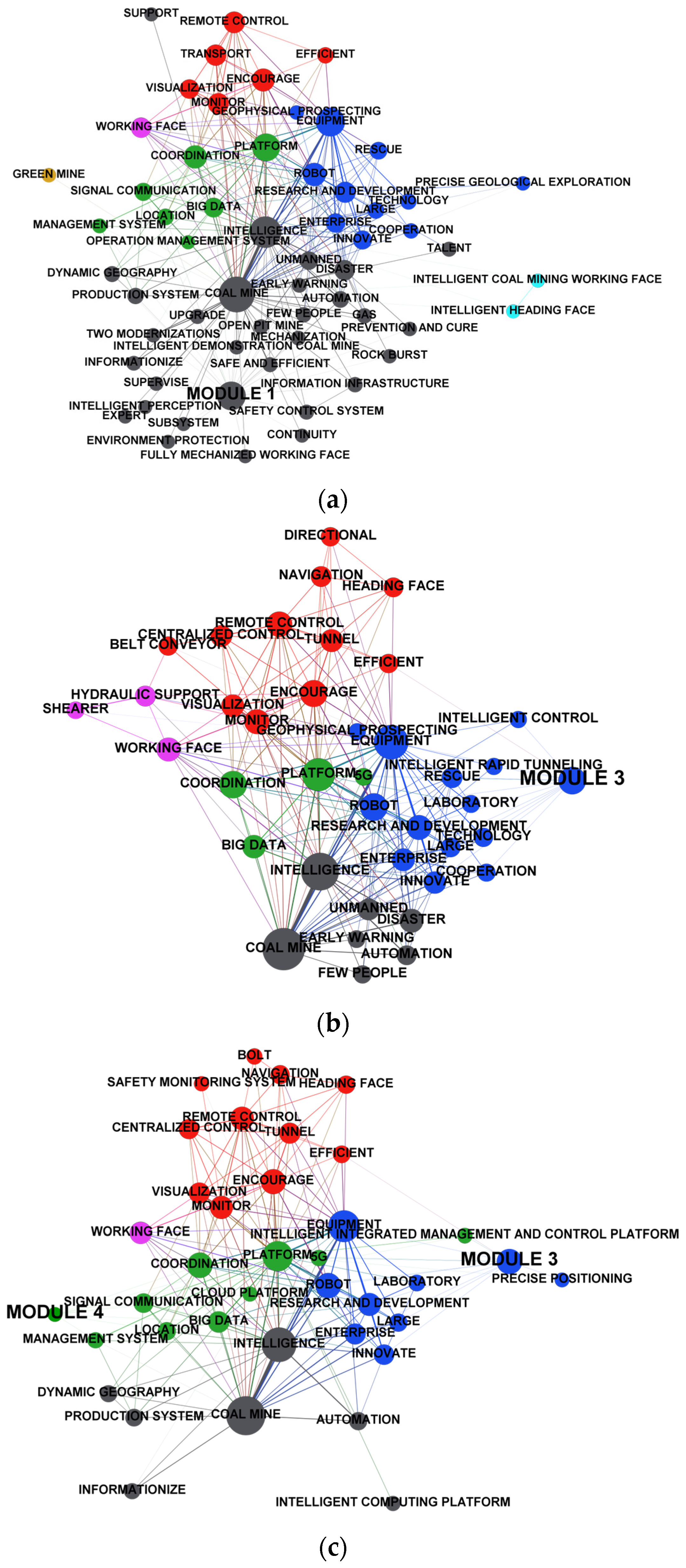
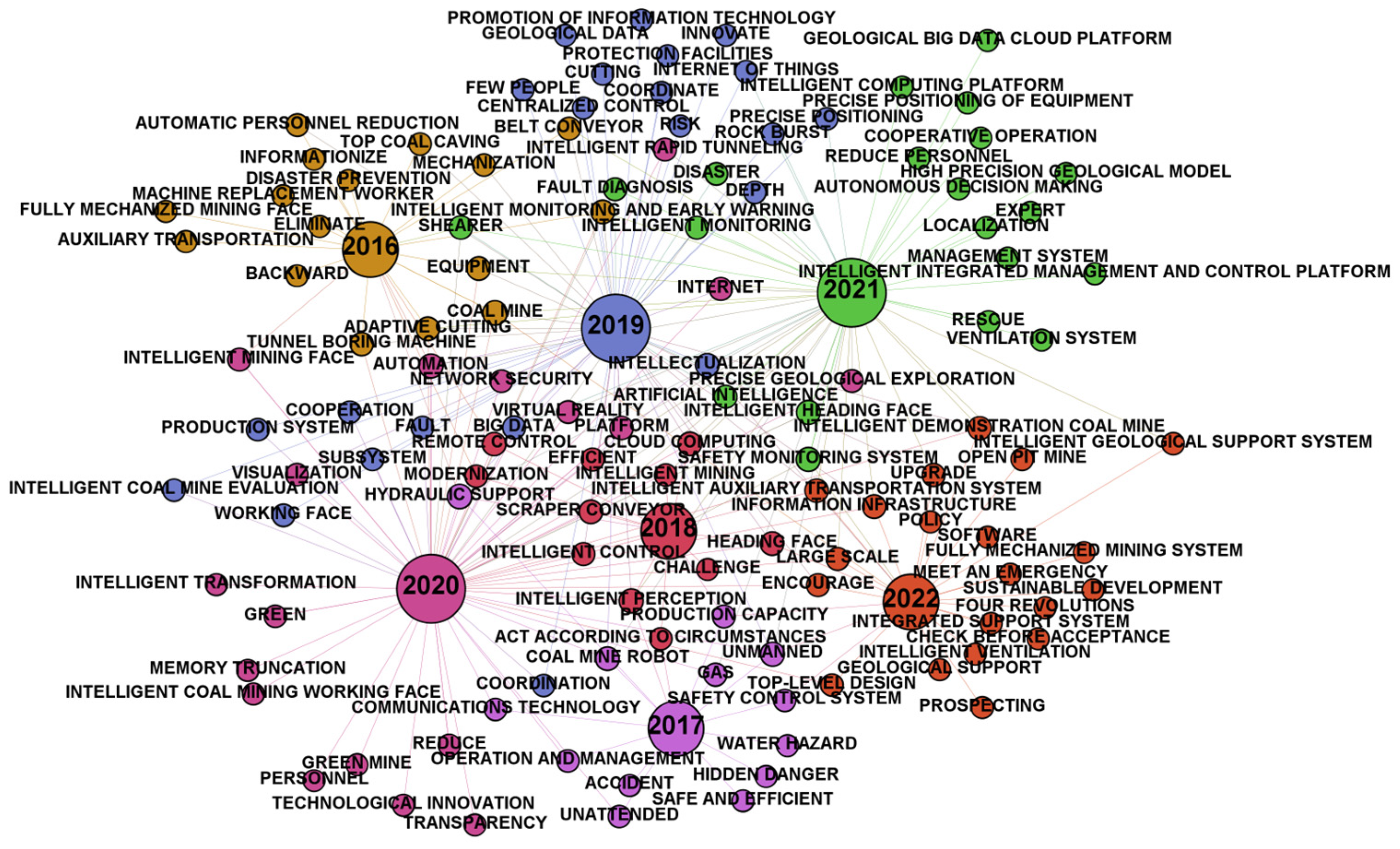
| Words | TF-IDF Value | Words | TF-IDF Value | Words | TF-IDF Value |
|---|---|---|---|---|---|
| intellectualization | 0.2340 | robot | 0.0285 | mechanization | 0.0145 |
| coal mine | 0.2072 | cooperation | 0.0284 | automation | 0.0141 |
| 5G | 0.0833 | encourage | 0.0255 | policy decision | 0.0136 |
| monitor | 0.0536 | early warning | 0.0246 | check before acceptance | 0.0132 |
| platform | 0.0442 | safe and efficient | 0.0242 | rock burst | 0.0128 |
| equipment | 0.0406 | disaster | 0.0222 | digitization | 0.0127 |
| working face | 0.0361 | upgrade | 0.0204 | fully mechanized mining | 0.0125 |
| internet | 0.0310 | long-range | 0.0202 | accurate | 0.0123 |
| automatic | 0.0289 | heading face | 0.0166 | unmanned | 0.0121 |
| enterprise | 0.0286 | promotion of information technology | 0.0147 | opencast mining | 0.0112 |
| Word | Degree |
|---|---|
| equipment | 36 |
| platform | 33 |
| big data | 15 |
| unmanned | 12 |
| information infrastructure | 5 |
| safety control system | 4 |
| talent | 4 |
| green mine | 3 |
| intelligent coal mining working face | 2 |
| intelligent heading face | 2 |
| Word | Degree |
|---|---|
| robot | 23 |
| coordination | 23 |
| working face | 16 |
| unmanned | 12 |
| hydraulic support | 10 |
| large | 8 |
| automation | 8 |
| belt conveyor | 7 |
| shearer | 4 |
| intelligent control | 3 |
| Word | Degree |
|---|---|
| remote control | 19 |
| big data | 15 |
| signal communication | 11 |
| efficient | 7 |
| 5G | 4 |
| informatization | 4 |
| intelligent computing platform | 2 |
| cloud platform | 2 |
| safety monitoring system | 2 |
| precise positioning | 1 |
| Number | Words | Degree | Closeness Centrality | Betweenness Centrality |
|---|---|---|---|---|
| 1 | coal mine | 51 | 0.632911 | 1339.74047 |
| 2 | intellectualization | 42 | 0.595238 | 710.14753 |
| 3 | equipment | 36 | 0.581395 | 532.344042 |
| 4 | platform | 33 | 0.568182 | 561.050618 |
| 5 | research and development | 18 | 0.492611 | 82.498955 |
| 6 | robot | 23 | 0.512821 | 198.836942 |
| 7 | big data | 15 | 0.485437 | 130.907198 |
| 8 | monitor | 18 | 0.520833 | 520.785928 |
| 9 | transport | 18 | 0.502513 | 314.862122 |
| 10 | unmanned | 12 | 0.456621 | 18.648321 |
| 111 | innovate | 13 | 0.46729 | 27.234098 |
| 112 | hydraulic support | 10 | 0.4329 | 41.257284 |
| 113 | heading face | 8 | 0.423729 | 6.373761 |
| 114 | automation | 8 | 0.446429 | 8.184273 |
| 115 | belt conveyor | 7 | 0.3861 | 33.569469 |
| 116 | support | 2 | 0.42735 | 8.467956 |
| 117 | internet of things | 3 | 0.367647 | 2.438542 |
| 118 | talent | 4 | 0.421941 | 43.160271 |
| 119 | safety monitoring system | 2 | 0.369004 | 1.672941 |
| 120 | fault diagnosis | 2 | 0.374532 | 0.479553 |
| Year | Typical Keywords | Trend |
|---|---|---|
| 2016 | automation, eliminate backward enterprises, informationize, equipment, modernization, machines replace workers, automatic personnel reduction | Eliminate backward enterprises, put forward the production concept of green development, safety and efficiency, and encourage mechanized replacement and automatic personnel reduction. |
| 2017 | mechanization, safety control system, disaster prevention, gas, automatic personnel reduction, machine replacement worker, eliminate | |
| 2018 | equipment, mechanization, green development, safe and efficient, intellectualization, disaster prevention, modernization | |
| 2019 | intellectualization, equipment, network security, artificial intelligence, internet of things, internet, tunnel boring machine, hydraulic support, shearer, coordination | Carry out the intelligent transformation of mining machinery and standardize the basic concepts and requirements of intelligent mines. |
| 2020 | intellectualization, intelligent demonstration coal mine, platform, subsystem, internet, coal mine robot, intelligent perception, intelligent monitoring | |
| 2021 | intellectualization, equipment, intelligent demonstration coal mine, coal mine robot, intelligent monitoring and early warning, precise positioning, virtual reality, geological big data cloud platform | Promote the application of key technologies of coal mine intellectualization, build intelligent demonstration coal mines, and the intellectualization of coal mines has further developed. |
| 2022 | intellectualization, intelligent demonstration coal mine, upgrade, information infrastructure, check before acceptance, intelligent ventilation, integrated support system |
Publisher’s Note: MDPI stays neutral with regard to jurisdictional claims in published maps and institutional affiliations. |
© 2022 by the authors. Licensee MDPI, Basel, Switzerland. This article is an open access article distributed under the terms and conditions of the Creative Commons Attribution (CC BY) license (https://creativecommons.org/licenses/by/4.0/).
Share and Cite
Wo, X.; Li, G.; Sun, Y.; Li, J.; Yang, S.; Hao, H. The Changing Tendency and Association Analysis of Intelligent Coal Mines in China: A Policy Text Mining Study. Sustainability 2022, 14, 11650. https://doi.org/10.3390/su141811650
Wo X, Li G, Sun Y, Li J, Yang S, Hao H. The Changing Tendency and Association Analysis of Intelligent Coal Mines in China: A Policy Text Mining Study. Sustainability. 2022; 14(18):11650. https://doi.org/10.3390/su141811650
Chicago/Turabian StyleWo, Xiaofang, Guichen Li, Yuantian Sun, Jinghua Li, Sen Yang, and Haoran Hao. 2022. "The Changing Tendency and Association Analysis of Intelligent Coal Mines in China: A Policy Text Mining Study" Sustainability 14, no. 18: 11650. https://doi.org/10.3390/su141811650
APA StyleWo, X., Li, G., Sun, Y., Li, J., Yang, S., & Hao, H. (2022). The Changing Tendency and Association Analysis of Intelligent Coal Mines in China: A Policy Text Mining Study. Sustainability, 14(18), 11650. https://doi.org/10.3390/su141811650









